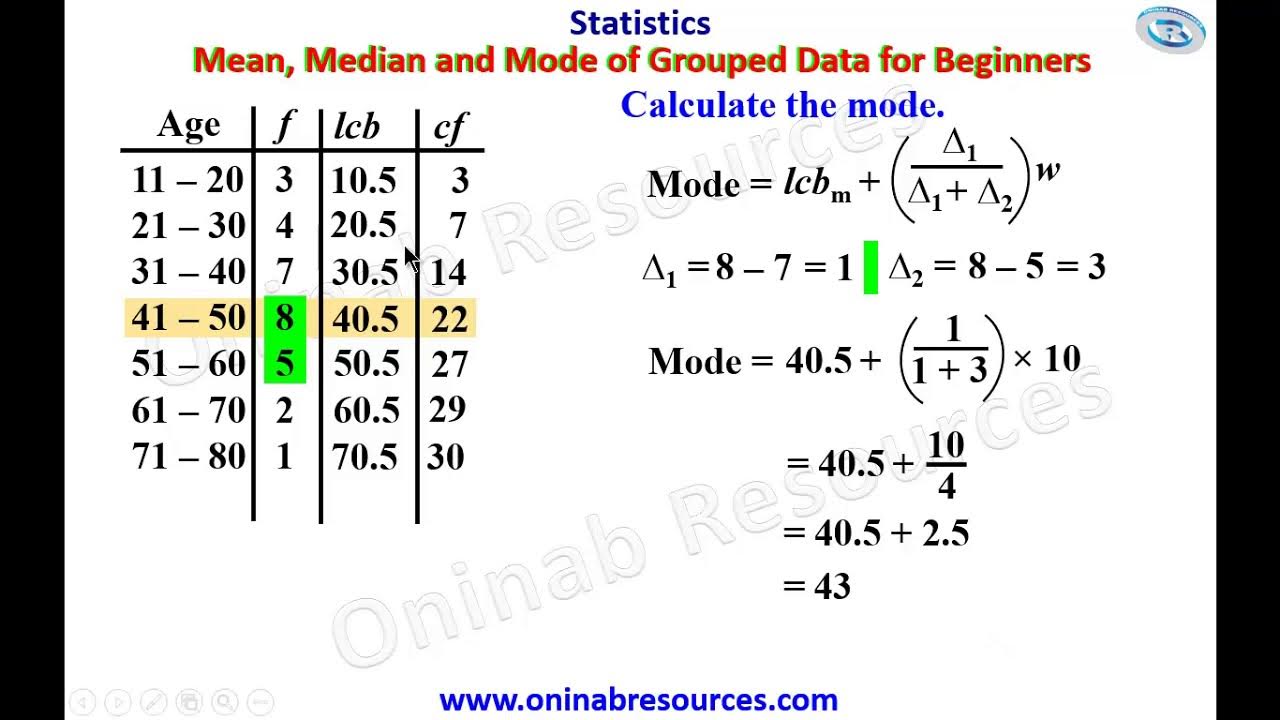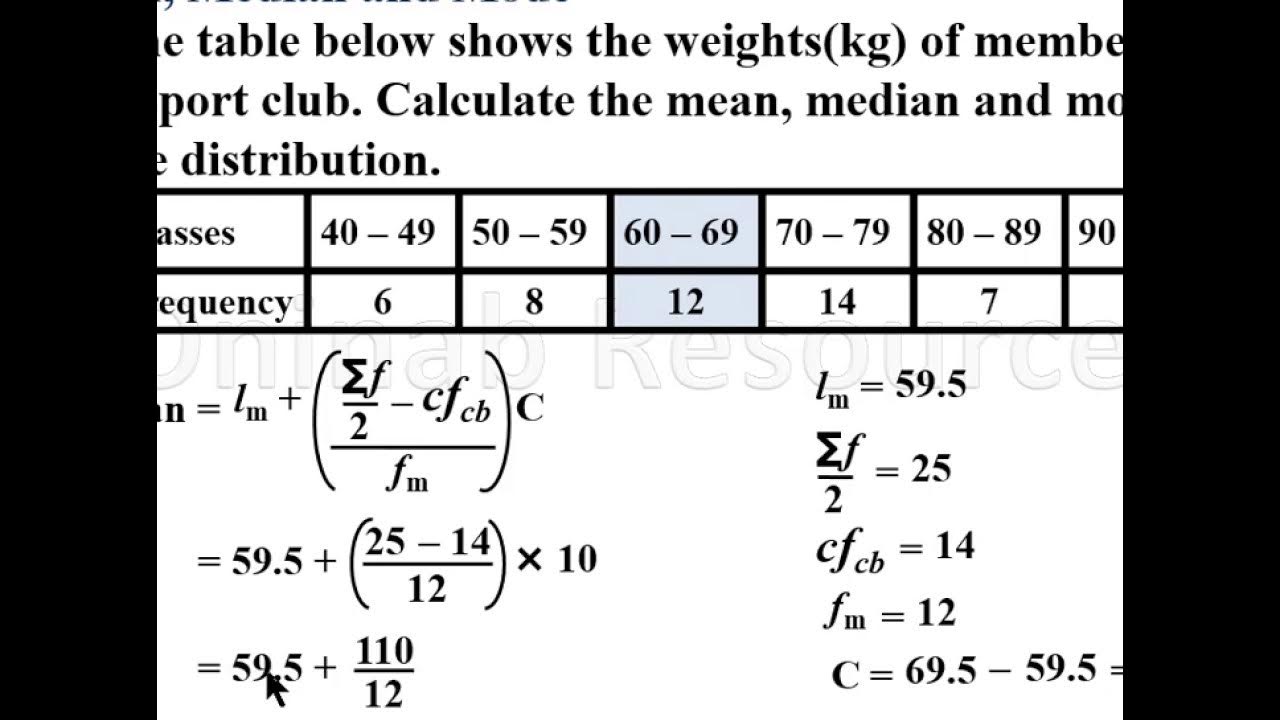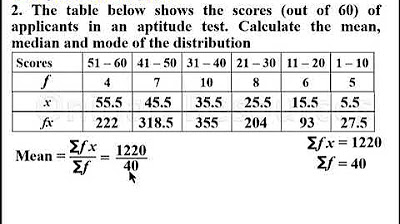FORM 2 MATHS STATISTICS I MEAN,MODE & MEDIAN
TLDRIn this mathematics class, the instructor introduces the concepts of mean, mode, and median in statistics, focusing on their calculation for grouped data. The mode is identified as the class with the highest frequency, here being 50-59 with 20 students. The mean is calculated using a frequency distribution table, resulting in a mean mark of 55.1. The median is determined by finding the middle value of the dataset, which, after calculating, is approximately 55. This lesson provides a clear guide to understanding and calculating these statistical measures in an educational setting.
Takeaways
- 📚 The class is focused on statistics for Form 2 mathematics students.
- 📈 The lesson covers how to calculate the mean, mode, and median of grouped data.
- 🔍 The mode is identified as the class with the highest frequency of students, which in this case is the 50-59 marks range with 20 students.
- 📝 To find the mean, a frequency distribution table is used, calculating the midpoint of each class interval and multiplying by the frequency.
- 🧮 The mean is calculated by summing all the products of frequency and midpoint (f*x), then dividing by the total number of students.
- 📉 The median is the middle value in a data set, and its position is found by taking half the total number of data points.
- 📊 Cumulative frequency is used to identify the median class, which is the class containing the middle value of the data set.
- 🔢 The median calculation involves the lower class limit of the median class, the cumulative frequency above the median class, and the class interval.
- 📌 The lower class limit is adjusted by subtracting half the class interval from it to find the exact median value.
- 📘 The example provided calculates the median as 55 by using the formula for median calculation with the given data.
- 👩🏫 The instructor emphasizes the importance of understanding the process of calculating statistical measures for grouped data.
Q & A
What is the topic of the mathematics class in the script?
-The topic of the mathematics class is 'Statistics 1', focusing on calculating the mean, mode, and median of grouped data.
How is the model class determined in the given data?
-The model class is determined as the class with the highest frequency. In the given data, the model class is 50-59, with a frequency of 20.
What is the formula used to calculate the mean mark?
-The formula used to calculate the mean mark is the sum of f times x (Σfx) divided by the sum of f (Σf).
What does 'x' represent in the frequency distribution table?
-'x' represents the midpoint of each class interval in the frequency distribution table.
How is the midpoint of a class interval calculated?
-The midpoint of a class interval is calculated by adding the lower and upper limits of the class interval and then dividing by 2.
What are the midpoints of the class intervals in the given data?
-The midpoints of the class intervals are: 30-39: 34.5, 40-49: 44.5, 50-59: 54.5, 60-69: 64.5, and 70-79: 74.5.
How is the cumulative frequency calculated?
-The cumulative frequency is calculated by adding the frequency of the current class to the cumulative frequency of the previous class.
What is the cumulative frequency for the class interval 50-59?
-The cumulative frequency for the class interval 50-59 is 34.
How is the median mark determined?
-The median mark is determined by finding the position of the median (which is at half of the total frequency) and then using the formula: median = L + [(N/2 - C)/f] * I, where L is the lower class limit of the median class, N is the total frequency, C is the cumulative frequency just above the median class, f is the frequency of the median class, and I is the class interval.
What is the median mark for the given data?
-The median mark for the given data is 55.
Outlines
📚 Introduction to Statistics
The script begins with a warm welcome to a mathematics class focused on statistics for Form 2 students. The instructor introduces the topics of mean, mode, and median calculation, specifically for grouped data. The class starts with a practical example involving the marks obtained by students in a mathematics test, which are presented in a grouped frequency table. The task is to identify the mode class, calculate the minimum mark, and determine the median mark. The mode class is identified as the group with the highest frequency, which in this case is the 50-59 marks bracket with 20 students.
📊 Calculating the Mean and Mode
The instructor proceeds to explain the process of calculating the mean mark using a frequency distribution table. The midpoint (x) of each class interval is calculated, followed by the multiplication of frequency (f) by the midpoint (fx). The sum of all fx values is then divided by the total frequency to find the mean mark. The mode class, which is the class with the highest frequency, is re-emphasized as the 50-59 marks bracket. The mean is calculated to be 55.1 after summing up the fx values and dividing by the total number of students, which is 50.
🔢 Determining the Median Mark
The final part of the script discusses the method for calculating the median mark. The median is the middle value of a data set when arranged in ascending order. The instructor demonstrates how to find the median by first determining the position of the median, which is half of the total frequency (n/2). A cumulative frequency table is used to identify the median class. The median is then calculated using the lower class limit (L), the cumulative frequency just above the median class (c), the class interval (i), and the frequency of the median class (f). The median mark is calculated to be 55 after applying the formula and considering the relevant values from the table.
Mindmap
Keywords
💡Mean
💡Mode
💡Median
💡Grouped Data
💡Frequency
💡Midpoint
💡Frequency Distribution Table
💡fx
💡Cumulative Frequency
💡Class Interval
💡Lower Class Limit
Highlights
Introduction to the mathematics class covering statistics for Form 2 students.
Topic: Calculating the mean, mode, and median of grouped data.
Marks obtained by students are provided in a grouped frequency table.
Explanation of the term 'modal class' and identification of the modal class (50-59) based on the highest frequency (20).
Step-by-step guide to calculating the mean, including drawing a frequency distribution table.
Definition of 'x' as the midpoint of the classes and calculation of midpoints for each class.
Detailed calculation of the product of frequency (f) and midpoint (x) for each class.
Formula for the mean: sum of (f*x) divided by sum of f, resulting in a mean of 55.1.
Explanation of the median, including the definition and its calculation method.
Introduction to cumulative frequency and its calculation for identifying the median class.
Calculation of the cumulative frequency column, leading to the identification of the median class (50-59).
Formula for the median involving the lower class limit, cumulative frequency, class interval, and frequency of the median class.
Detailed calculation of the median using the provided formula, resulting in a median of 55.
Summarization of key points: identifying the modal class, calculating the mean, and determining the median.
Emphasis on the importance of understanding statistical measures in analyzing grouped data.
Transcripts
Browse More Related Video

Measure of Central Tendency of Grouped Data for beginners

Statistics - Mean, Median & Mode for a grouped frequency data

Measures of Central Tendency (Grouped Data) | Basic Statistics

Mean, median and mode of grouped Data(Lesson 1)

Mean, Median and Mode of Grouped Data(Lesson 2)

The Maths Prof: Frequency Tables (Mean, Median, Mode & Range)
5.0 / 5 (0 votes)
Thanks for rating: